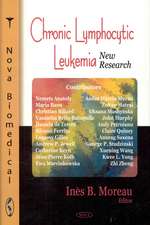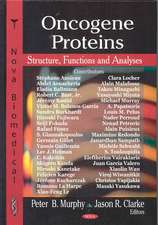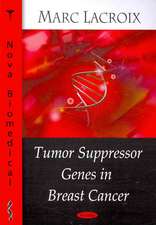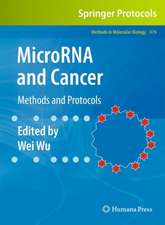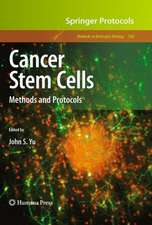CNS Cancer: Models, Markers, Prognostic Factors, Targets, and Therapeutic Approaches: Cancer Drug Discovery and Development
Editat de Erwin G. Van Meiren Limba Engleză Hardback – 30 iul 2009
Din seria Cancer Drug Discovery and Development
- 5%
 Preț: 1108.35 lei
Preț: 1108.35 lei - 5%
 Preț: 1415.75 lei
Preț: 1415.75 lei - 5%
 Preț: 1370.22 lei
Preț: 1370.22 lei - 5%
 Preț: 1452.28 lei
Preț: 1452.28 lei - 5%
 Preț: 1316.76 lei
Preț: 1316.76 lei - 5%
 Preț: 1439.50 lei
Preț: 1439.50 lei - 5%
 Preț: 1113.63 lei
Preț: 1113.63 lei - 5%
 Preț: 1126.24 lei
Preț: 1126.24 lei - 24%
 Preț: 1037.62 lei
Preț: 1037.62 lei - 5%
 Preț: 1466.37 lei
Preț: 1466.37 lei - 5%
 Preț: 1350.83 lei
Preț: 1350.83 lei - 5%
 Preț: 1417.54 lei
Preț: 1417.54 lei - 5%
 Preț: 1113.46 lei
Preț: 1113.46 lei - 5%
 Preț: 1428.54 lei
Preț: 1428.54 lei - 5%
 Preț: 1429.80 lei
Preț: 1429.80 lei - 5%
 Preț: 782.10 lei
Preț: 782.10 lei - 5%
 Preț: 1438.58 lei
Preț: 1438.58 lei - 5%
 Preț: 1110.32 lei
Preț: 1110.32 lei - 5%
 Preț: 1434.39 lei
Preț: 1434.39 lei - 5%
 Preț: 1365.85 lei
Preț: 1365.85 lei - 5%
 Preț: 1461.08 lei
Preț: 1461.08 lei - 5%
 Preț: 1106.86 lei
Preț: 1106.86 lei - 5%
 Preț: 982.20 lei
Preț: 982.20 lei - 5%
 Preț: 727.80 lei
Preț: 727.80 lei - 5%
 Preț: 1331.78 lei
Preț: 1331.78 lei - 5%
 Preț: 1297.43 lei
Preț: 1297.43 lei - 5%
 Preț: 1124.59 lei
Preț: 1124.59 lei - 5%
 Preț: 1433.10 lei
Preț: 1433.10 lei - 5%
 Preț: 1110.90 lei
Preț: 1110.90 lei - 5%
 Preț: 1317.79 lei
Preț: 1317.79 lei - 5%
 Preț: 1464.91 lei
Preț: 1464.91 lei - 5%
 Preț: 1939.63 lei
Preț: 1939.63 lei - 5%
 Preț: 1418.48 lei
Preț: 1418.48 lei - 5%
 Preț: 1438.94 lei
Preț: 1438.94 lei - 5%
 Preț: 1100.30 lei
Preț: 1100.30 lei - 5%
 Preț: 1109.96 lei
Preț: 1109.96 lei - 5%
 Preț: 990.60 lei
Preț: 990.60 lei - 5%
 Preț: 1443.13 lei
Preț: 1443.13 lei - 5%
 Preț: 1428.91 lei
Preț: 1428.91 lei - 5%
 Preț: 787.58 lei
Preț: 787.58 lei - 5%
 Preț: 1311.75 lei
Preț: 1311.75 lei - 5%
 Preț: 1331.78 lei
Preț: 1331.78 lei - 5%
 Preț: 1113.11 lei
Preț: 1113.11 lei - 5%
 Preț: 1440.76 lei
Preț: 1440.76 lei
Preț: 1474.98 lei
Preț vechi: 1552.60 lei
-5% Nou
Puncte Express: 2212
Preț estimativ în valută:
282.33€ • 306.77$ • 237.31£
282.33€ • 306.77$ • 237.31£
Carte disponibilă
Livrare economică 01-15 aprilie
Preluare comenzi: 021 569.72.76
Specificații
ISBN-13: 9781603275521
ISBN-10: 1603275525
Pagini: 762
Ilustrații: XII, 1284 p. 160 illus., 64 illus. in color. With 2 16-page color inserts.
Dimensiuni: 155 x 235 x 66 mm
Greutate: 2.04 kg
Ediția:2009
Editura: Humana Press Inc.
Colecția Humana
Seria Cancer Drug Discovery and Development
Locul publicării:Totowa, NJ, United States
ISBN-10: 1603275525
Pagini: 762
Ilustrații: XII, 1284 p. 160 illus., 64 illus. in color. With 2 16-page color inserts.
Dimensiuni: 155 x 235 x 66 mm
Greutate: 2.04 kg
Ediția:2009
Editura: Humana Press Inc.
Colecția Humana
Seria Cancer Drug Discovery and Development
Locul publicării:Totowa, NJ, United States
Public țintă
Professional/practitionerCuprins
Animal Models for Central Nervous Tumors.- Modeling Gliomas Using PDGF-Expressing Retroviruses.- Modeling Brain Tumors Using Avian Retroviral Gene Transfer.- Using Neurofibromatosis Type 1 Mouse Models to Understand Human Pediatric Low-Grade Gliomas.- Transgenic Mouse Models of CNS Tumors: Using Genetically Engineered Murine Models to Study the Role of p21-Ras in Glioblastoma Multiforme.- Pten-Deficient Mouse Models for High-Grade Astrocytomas.- The Nf1–/+; Trp53–/+cis Mouse Model of Anaplastic Astrocytoma and Secondary Glioblastoma: Dissecting Genetic Susceptibility to Brain Cancer.- Modeling Astrocytomas in a Family of Inducible Genetically Engineered Mice: Implications for Preclinical Cancer Drug Development.- Human Brain Tumor Cell and Tumor Tissue Transplantation Models.- Transformed Human Brain Cells in Culture as a Model for Brain Tumors.- Rat Glioma Models for Preclinical Evaluation of Novel Therapeutic and Diagnostic Modalities.- Neuro-oncogenesis Induced by Nitroso Compounds in Rodents and Strain-Specific Genetic Modifiers of Predisposition.- The Murine GL261 Glioma Experimental Model to Assess Novel Brain Tumor Treatments.- Spontaneous Occurrence of Brain Tumors in Animals: Opportunities as Preclinical Model Systems.- Prognostic Factors and Biomarkers.- p53 Pathway Alterations in Brain Tumors.- The PTEN/PI3 Kinase Pathway in Human Glioma.- Value of 1p/19q and Other LOH Markers for Brain Tumor Diagnosis, Prognosis, and Therapy.- Discovery of Genetic Markers for Brain Tumors by Comparative Genomic Hybridization.- Genomic Identification of Significant Targets in Brain Cancer.- Oncomodulatory Role of the Human Cytomegalovirus in Glioblastoma.- Aberrant EGFR Signaling in Glioma.- Mechanisms of Brain Tumor Angiogenesis.- Vaso-occlusive Mechanisms that IntiateHypoxia and Necrosis in Glioblastoma: The Role of Thrombosis and Tissue Factor.- Transcription Profiling of Brain Tumors: Tumor Biology and Treatment Stratification.- Proteomic Profiling of Human Brain Tumors.- Proteomic Discovery of Biomarkers in the Cerebrospinal Fluid of Brain Tumor Patients.- Epigenetic Profiling of Gliomas.- MicroRNAs in the Central Nervous System and Potential Roles of RNA Interference in Brain Tumors.- Of Escherichia coli and Man: Understanding Glioma Resistance to Temozolomide Therapy.- Brain Tumor Stem Cell Markers.- Therapeutic Targets and Targeting Approaches.- Clinical Agents for the Targeting of Brain Tumor Vasculature.- Bone Marrow-Derived Cells in GBM Neovascularization.- Vascular Targeting of Brain Tumors – Bridging the Gap with Phage Display.- Impact of the Blood–Brain Barrier on Brain Tumor Imaging and Therapy.- Targeting CXCR4 in Brain Tumors.- Molecular Targeting of IL-13R?2 and EphA2 Receptor in GBM.- Molecular Targets for Antibody-Mediated Immunotherapy of Malignant Glioma.- Stat3 Oncogenic Signaling in Glioblastoma Multiforme.- Inhibition of Ras Signaling for Brain Tumor Therapy.- HGF/c-Met Signaling and Targeted Therapeutics in Brain Tumors.- Combinatorial Therapeutic Strategies for Blocking Kinase Pathways in Brain Tumors.- Targeting of TRAIL Apoptotic Pathways for Glioblastoma Therapies.- The NF-?B Signaling Pathway in GBMs: Implications for Apoptotic and Inflammatory Responses and Exploitation for Therapy.- Targeting Endoplasmic Reticulum Stress for Malignant Glioma Therapy.- Brain Cancer Stem Cells as Targets of Novel Therapies.- The Use of Retinoids as Differentiation Agents Against Medulloblastoma.- Herpes Simplex Virus 1 (HSV-1) for Glioblastoma Multiforme Therapy.- The Development of Targeted Cancer Gene-TherapyAdenoviruses for High-Grade Glioma Treatment.- Harnessing T-Cell Immunity to Target Brain Tumors.- Glioma Invasion: Mechanisms and Therapeutic Challenges.
Notă biografică
Erwin G Van Meir is Professor of Neurosurgery and Hematology & Medical Oncology in the School of Medicine at Emory University. A native of Belgium, he obtained Bachelor’s degrees in Biology and Education at the University of Fribourg, Switzerland. He pursued graduate studies in Molecular Virology at the University of Lausanne, Switzerland where he obtained his PhD in 1989. He then became interested in cancer and pursued postdoctoral work at the University Hospital in Lausanne and at the Ludwig Institute for Cancer Research in San Diego. In 1994 he became a Junior Faculty and Director of the Laboratory of Brain Tumor Biology and Genetics in the Neurosurgery Department at the University of Lausanne. In 1998 he joined Emory University in Atlanta, where he now serves as the Leader of the Winship Cancer Institute Molecular Pathways and Biomarkers scientific program and as the co-Director of the brain tumor working group.
For the past 20 years Dr. Van Meir’s research has focused on defining the biological significance of specific genetic alterations for brain tumor development, with particular emphasis on extracellular signaling regulating heterotypic cell communication as in tumor angiogenesis, and translating this knowledge into new therapeutic approaches. His research is described in more than 140 peer-reviewed research papers and review articles in internationally recognized journals that have cumulated over 5,000 citations and received several awards. These contributions were presented in over 100 invited seminars worldwide and have furthered the understanding of cytokine expression for glioma biology, Turcot syndrome, the role of transcription factors p53 and HIF and of pro- and anti-angiogenesis factors IL-8, thrombospondin-1 and brain angiogenesis inhibitor-1 in brain tumor angiogenesis, hypoxia, and pseudopalisade formation. He also discovered novel biomarkers in the cerebrospinal fluid of brain tumor patients and developednovel therapeutic agents including oncolytic hypoxia-activated adenoviruses, pro-apoptotic galectin-3, anti-angiogenic vasculostatins and small molecule HIF/Hsp90/plectin1 inhibitors that are covered by several US and foreign patents. Perhaps most importantly, over his still young 20 year independent career Dr Van Meir has already mentored and trained over 60 postdoctoral fellows, students and visiting scientists, many of which now hold independent leading positions in Academia or Industry.
Dr Van Meir is an active member of the International Neuro-Oncology community and served on the Board of Directors of the Society for Neuro-Oncology from 2004-2008. He organized several international conferences on brain tumors, has served on the Scientific Committee of the European Association for Neuro-Oncology, the Scientific Advisory Board of the Southeastern Brain Tumor Foundation and is a current or former member of several other international cancer societies including the American Association for Cancer Research, the European Association for Cancer Research, and the American Society for Investigative Pathology.
Dr. Van Meir currently serves on the Editorial Board of Neuro-Oncology, Frontiers in Bioscience, and International Journal of Oncology and is a former Associate Editor of the International Journal of Cancer. He has served as a reviewer for over 30 international scientific journals and for grant proposals from public and private agencies including the US National Institutes of Health, the US Department of Defense, the Swiss National Science Foundation, the Swiss Cancer Society, the Wellcome Trust of the UK, Cancer Research UK, the Research Grants Council of Hong Kong, the Israel Science Foundation, The Belgian Fournier-Majoie and Baudouin Foundations and the Italian Association for Cancer Research.
He acknowledges present and past support by multiple funding agencies for his scientific work, including the US National Institutes of Health, the Swiss National Science Foundation, the Goldhirsh Foundation, the Charlotte Geyer Foundation, the Southeastern and National Brain Tumor Foundations, The Brain Tumor Society, the Pediatric Brain Tumor Foundation of the US, the American Brain Tumor Association, the Brain Tumor Foundation for Children, the Al Musella, Wayne O Rollins and Frances Wood Wilson Foundations, the Brain Tumor Trust, the Emory University Research Council and EmTechBio, the Swiss Cancer League and Anti-Cancer Foundations, the San Salvatore, Tossizza, Ott and Chuard-Smith Foundations, and the European Institute of Oncology.
For the past 20 years Dr. Van Meir’s research has focused on defining the biological significance of specific genetic alterations for brain tumor development, with particular emphasis on extracellular signaling regulating heterotypic cell communication as in tumor angiogenesis, and translating this knowledge into new therapeutic approaches. His research is described in more than 140 peer-reviewed research papers and review articles in internationally recognized journals that have cumulated over 5,000 citations and received several awards. These contributions were presented in over 100 invited seminars worldwide and have furthered the understanding of cytokine expression for glioma biology, Turcot syndrome, the role of transcription factors p53 and HIF and of pro- and anti-angiogenesis factors IL-8, thrombospondin-1 and brain angiogenesis inhibitor-1 in brain tumor angiogenesis, hypoxia, and pseudopalisade formation. He also discovered novel biomarkers in the cerebrospinal fluid of brain tumor patients and developednovel therapeutic agents including oncolytic hypoxia-activated adenoviruses, pro-apoptotic galectin-3, anti-angiogenic vasculostatins and small molecule HIF/Hsp90/plectin1 inhibitors that are covered by several US and foreign patents. Perhaps most importantly, over his still young 20 year independent career Dr Van Meir has already mentored and trained over 60 postdoctoral fellows, students and visiting scientists, many of which now hold independent leading positions in Academia or Industry.
Dr Van Meir is an active member of the International Neuro-Oncology community and served on the Board of Directors of the Society for Neuro-Oncology from 2004-2008. He organized several international conferences on brain tumors, has served on the Scientific Committee of the European Association for Neuro-Oncology, the Scientific Advisory Board of the Southeastern Brain Tumor Foundation and is a current or former member of several other international cancer societies including the American Association for Cancer Research, the European Association for Cancer Research, and the American Society for Investigative Pathology.
Dr. Van Meir currently serves on the Editorial Board of Neuro-Oncology, Frontiers in Bioscience, and International Journal of Oncology and is a former Associate Editor of the International Journal of Cancer. He has served as a reviewer for over 30 international scientific journals and for grant proposals from public and private agencies including the US National Institutes of Health, the US Department of Defense, the Swiss National Science Foundation, the Swiss Cancer Society, the Wellcome Trust of the UK, Cancer Research UK, the Research Grants Council of Hong Kong, the Israel Science Foundation, The Belgian Fournier-Majoie and Baudouin Foundations and the Italian Association for Cancer Research.
He acknowledges present and past support by multiple funding agencies for his scientific work, including the US National Institutes of Health, the Swiss National Science Foundation, the Goldhirsh Foundation, the Charlotte Geyer Foundation, the Southeastern and National Brain Tumor Foundations, The Brain Tumor Society, the Pediatric Brain Tumor Foundation of the US, the American Brain Tumor Association, the Brain Tumor Foundation for Children, the Al Musella, Wayne O Rollins and Frances Wood Wilson Foundations, the Brain Tumor Trust, the Emory University Research Council and EmTechBio, the Swiss Cancer League and Anti-Cancer Foundations, the San Salvatore, Tossizza, Ott and Chuard-Smith Foundations, and the European Institute of Oncology.
Textul de pe ultima copertă
CNS Cancer: Models, Markers, Prognostic Factors and Therapeutic Approaches
Erwin G. Van Meir
Cancers of the central nervous system are among the most lethal of human neoplasms. They are recalcitrant to even intensive multimodality therapies that include surgery, radiotherapy and chemotherapy. Moreover, especially in children, the consequences of these therapies can itself be devastating and involve serious cognitive and developmental disorders. It is small wonder that such cancers have come under the intense scrutiny of each of the subspecialties of clinical care and investigation as well as attracting some of the best basic research scientists. Their joint efforts are gradually peeling away the mysteries surrounding the genesis and progression of these tumors and inroads are being steadily made into understanding why they resist therapies.This makes it an especially opportune time to assemble some of the best investigators in the field to review the "state of the art" in the various arenas that comprise the assault on CNS tumors. While the lethality of these tumors has remained dismal over the past decades, there is finally real reason for optimism as our knowledge base grows exponentially larger.
The major areas of this endeavor are displayed in CNS Cancer: Models, Markers, Prognostic Factors and Therapeutic Approaches. Each of the chapters in the book represents illustrative examples of the road from discovery through translation to clinical importance, although many begin the journey at different parts of this continuum. This includes several chapters on incredibly clever mouse models for deciphering the genetic wiring underlying the development of CNS tumors and how that wiring might be targeted for therapeutic benefit. A great deal of attention has been paid in the book to the development of genetic prognostic factors and biomarkers that could be used for assessing individual responses to therapies and socould lead to truly personalized medicine. Other possible prognostic factors/biomarkers that arise from an understanding of CNS tumor pathophysiology are discussed in some detail and include tumor vascularization and hypoxia. Several of the new and rapidly developing methodologies that allow these rapid advances are detailed for the reader as well and include RNA expression profiling, proteomic analyses of both tumors and biological fluids as well as profiling small non-coding RNAs and DNA modification. Finally, several chapters explore aspects of therapeutic targeting employing small molecules and combinations thereof, various sorts of cells, viruses and immune modulation. In sum, these treatises represent the cutting edge of research that is driven to be of benefit to patients with these dreaded diseases.
Erwin G. Van Meir is Professor of Neurosurgery and Hematology & Medical Oncology in the School of Medicine at Emory University. A native of Belgium, he obtained Bachelor’s degrees in Biology and Education at the University of Fribourg, Switzerland. Dr Van Meir is an active member of the International Neuro-Oncology community and served on the Board of Directors of the Society for Neuro-Oncology from 2004-2008. Dr. Van Meir currently serves on the Editorial Board of Neuro-Oncology, Frontiers in Bioscience, and International Journal of Oncology and is a former Associate Editor of the International Journal of Cancer. He has served as a reviewer for over 30 international scientific journals and for grant proposals from public and private agencies.
Erwin G. Van Meir
Cancers of the central nervous system are among the most lethal of human neoplasms. They are recalcitrant to even intensive multimodality therapies that include surgery, radiotherapy and chemotherapy. Moreover, especially in children, the consequences of these therapies can itself be devastating and involve serious cognitive and developmental disorders. It is small wonder that such cancers have come under the intense scrutiny of each of the subspecialties of clinical care and investigation as well as attracting some of the best basic research scientists. Their joint efforts are gradually peeling away the mysteries surrounding the genesis and progression of these tumors and inroads are being steadily made into understanding why they resist therapies.This makes it an especially opportune time to assemble some of the best investigators in the field to review the "state of the art" in the various arenas that comprise the assault on CNS tumors. While the lethality of these tumors has remained dismal over the past decades, there is finally real reason for optimism as our knowledge base grows exponentially larger.
The major areas of this endeavor are displayed in CNS Cancer: Models, Markers, Prognostic Factors and Therapeutic Approaches. Each of the chapters in the book represents illustrative examples of the road from discovery through translation to clinical importance, although many begin the journey at different parts of this continuum. This includes several chapters on incredibly clever mouse models for deciphering the genetic wiring underlying the development of CNS tumors and how that wiring might be targeted for therapeutic benefit. A great deal of attention has been paid in the book to the development of genetic prognostic factors and biomarkers that could be used for assessing individual responses to therapies and socould lead to truly personalized medicine. Other possible prognostic factors/biomarkers that arise from an understanding of CNS tumor pathophysiology are discussed in some detail and include tumor vascularization and hypoxia. Several of the new and rapidly developing methodologies that allow these rapid advances are detailed for the reader as well and include RNA expression profiling, proteomic analyses of both tumors and biological fluids as well as profiling small non-coding RNAs and DNA modification. Finally, several chapters explore aspects of therapeutic targeting employing small molecules and combinations thereof, various sorts of cells, viruses and immune modulation. In sum, these treatises represent the cutting edge of research that is driven to be of benefit to patients with these dreaded diseases.
Erwin G. Van Meir is Professor of Neurosurgery and Hematology & Medical Oncology in the School of Medicine at Emory University. A native of Belgium, he obtained Bachelor’s degrees in Biology and Education at the University of Fribourg, Switzerland. Dr Van Meir is an active member of the International Neuro-Oncology community and served on the Board of Directors of the Society for Neuro-Oncology from 2004-2008. Dr. Van Meir currently serves on the Editorial Board of Neuro-Oncology, Frontiers in Bioscience, and International Journal of Oncology and is a former Associate Editor of the International Journal of Cancer. He has served as a reviewer for over 30 international scientific journals and for grant proposals from public and private agencies.
Caracteristici
The volume will cover three areas of research in brain tumors Includes supplementary material: sn.pub/extras



